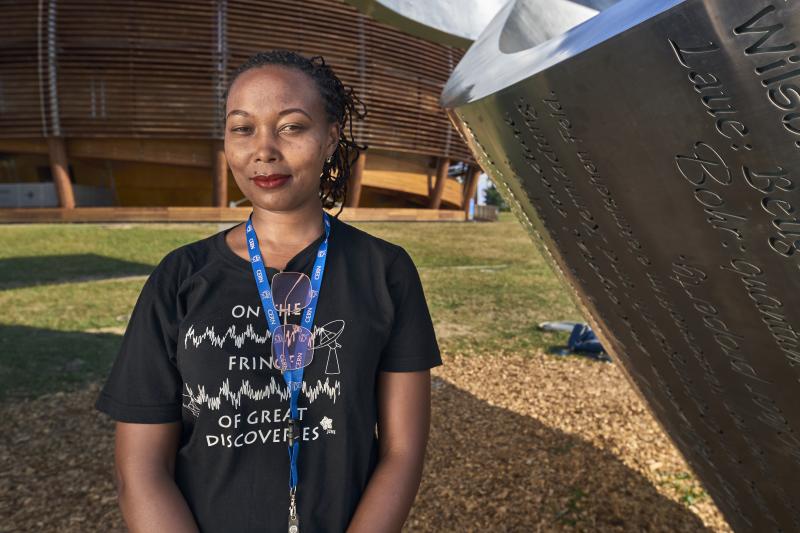I remember my first Monday morning at CERN. I was running because I was a bit late and had to catch a shuttle bus. The bus had dropped off students at building 500, everybody was getting off and I was left alone. So I asked the bus driver if he was driving to or near the Globe. This was the place of my instruction. He did not speak English. I did not speak French. He shook his head and I presumed it was a “no”. So I asked him in my very pathetic French how to get to the Globe from building 500. I had the CERN Map app, but it was my first day and the app did not make much sense. It was almost nine, and I had to find my way to the Globe. How? I did not know. Then imagine my horror when I saw the same bus driver with the same bus at the Car Park near the globe a few minutes later!
Fast forward. I head to the EP-CMX-GEM laboratory, building 904 at the CERN Prevessin site on the French side. All based on instructions given by my supervisor, Jeremie Alexander Merlin, over email. It is quite a steep learning curve on your first day at CERN. You have no idea how huge CERN is until you get there and get lost trying to get from one point to another.
My summer project involved making, together with a fellow summer intern, Axel Buchot Perraguin, a safety file for the new EP-CMX-GEM Laboratory and preparing an online safety course for the lab based on the safety file. The upgrade of the LHC during the long shutdown (LS2) in 2019 will result in an increase in the luminosity levels of up to 2x1034 cm-2s-1. Thus, the endcap region of the Compact Muon Solenoid (CMS) needs to be upgraded as well so as to improve the muon triggering and reconstruction in the face of these very high luminosities. Therefore, the Gas Electron Multiplier (GEM) of the CMS muon system, which is the first station encountered by particles from the interaction point, need to be upgraded.
The CMS GEM muon group is in charge of the construction and quality control of 161 large triple-GEM detectors for the upgrade of the CMS muon endcaps. The large majority of the production will take place at CERN, in a facility specifically built for this purpose. The construction of this new GEM facility required a complete review and update of various safety features such as the smoke detection system, emergency exits, extinguishers, and other specific items such as the identification of radiation zones.
Thus, the main objective of my summer project was to create a general safety file including the identification of all possible hazards, risk evaluation, and actions taken to minimize or suppress all risks in the research and development laboratory. The safety rules are based on CERN’s regulations and the European standards on safety in workplaces. They involved hazard identification and conformity assessment, risk assessment and created a chemical inventory for the laboratory.
At the end of my placement, the file and the online course were successfully submitted to the CERN safety department for final approval. This course will eventually be added to the CERN online training portfolio and will be mandatory in order to access the CMS-GEM lab.
I really love the diversity I encountered at CERN. The head of the GEM laboratory is from Italy, my supervisor is French and the other summer students in the laboratory were from all over the world: India, Singapore, Sri Lanka, Canada, United States, United Kingdom, Qatar, Tajikistan, Italy, France and of course myself from Kenya.
Another aspect I like about working at CERN is the fact that I was not treated as a student but as a fellow member of personnel for these few months. And it gives one this feeling of belonging, you feel like a team member and this makes one give their best! So whenever I would meet people within CERN and they would ask me “which experiment are you working with?” and I'd be like “CMS”, proudly! It was such a great feeling.
Besides attending the very diverse summer lectures throughout July and the summer project, I also traveled around Europe, Switzerland and fully explored Geneva.
Getting accepted for the Non-Member States (NMS) CERN Summer Students Program was a dream come true and the opportunity to work at the mighty CERN was something beyond my wildest imagination, as well as working with the CMS collaboration, that operates one of the largest experiments at CERN. I am still in disbelief, weeks after the end of the program. Everybody was so helpful and welcoming and my supervisor was the coolest ever. I had the summer of my life and I would encourage everyone to apply to the program. Apparently, I am the first NMS student from my country Kenya, and I feel honored and blessed. Thank you CERN and CMS.
The views expressed in CMS blogs are personal views of the author and do not necessarily represent official views of the CMS collaboration.

